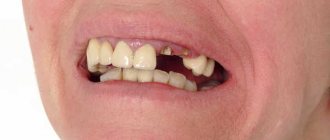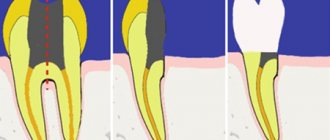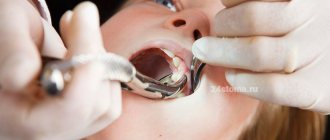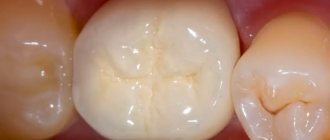Before
After
When there is no trace left of the dental crown, and all the roots are in place, a fair question arises: what to do next? Should this tooth be considered completely lost, or does the presence of the root provide a chance for restoration? Modern dentists, in the fight for every saved tooth, offer several options for solving this problem. The main thing is to make sure that the roots are healthy, there are no cysts, granulomas, inflammatory or carious formations on them.
Basic methods of teeth extension and restoration
- Composite building - the main characteristics and advantages of the method of restoration with such material
For this type of extension, composite filling materials are used. These multi-component compositions allow you to reliably and quickly remove the defect, restoring a beautiful row of teeth. The material is exposed to ultraviolet rays, causing the base to harden. The average lifespan of a tooth augmented with this material is up to 10 years. Over time, the filling loses its strength and aesthetic characteristics, and therefore it is recommended to repeat the extension.
Advantages of composite fillings when building:
- a fairly reliable filling for a tooth, but slightly inferior to a photopolymer;
- service life after this method of extension is up to five years;
- affordable treatment - cheaper than photopolymer.
- Photopolymer extension – features and advantages of the restoration method
- impeccable aesthetics;
- the reliability of the photopolymer is higher than that of composites;
- a variety of complexity groups, which allows you to close almost any defects;
- service life after extension – up to ten years;
- The photopolymer hardens quickly. Restoring the structure in this way is very comfortable for the doctor.
Teeth augmentation with photopolymer (dental light polymer) is a method of restoring the integrity of a tooth using a light-curing material. A photopolymer (monomer or low molecular weight monomer) hardens when exposed to light.
Advantages of photopolymer fillings for tooth extension:
What is the difference between the method of tooth augmentation with composites and photopolymer restoration? Composite means a combination of substances, that is, several chemical components are mixed to form a filling, and a “chemical multi-component filling” is obtained. Composites are used to restore the back of the tooth, and photopolymers are used for the front zone of the smile, which is why the latter materials are an order of magnitude more expensive than composites.
A veneer is a thin plate that sits on a tooth using a special glue. The main goal of a dental procedure is to give teeth a flawless appearance in terms of color, shape and clarity. The method of building up teeth with such onlays is more of an aesthetic restoration. Veneers, as a rule, are placed on the smile zone (front 8 - 10 units) of the upper jaw, and the lower teeth (if they are healthy) are whitened to the shade of the plates themselves.
Advantages of veneers for tooth extension and restoration:
- impeccable appearance;
- speed of manipulation;
- the ability to use extensions to correct a slight curvature of the tooth;
- plates can cover chips, microcracks, yellowish or brownish stains on teeth, thinning enamel;
- veneers correct the presence of gaps between teeth;
- the linings retain their shape, color, and transparency throughout their entire service life.
Depending on the installation method, there are the following types of veneers for teeth extension:
- ceramic – ready-made plates that are pre-fabricated in a dental laboratory. They are considered more reliable than composite ones, but at the same time they are several times more expensive;
- composite - the same composite fillings that are built up by an esthetician dentist directly in the patient’s oral cavity.
The main nuance of installing ceramic plates is the need to grind down healthy tooth enamel before the extension. And this process is irreversible, i.e., if you want to refuse veneers in the future, they will be removed, but the tooth will be without the top layer.
Installing a ceramic veneer does not mean that it will last the patient’s entire life after the extension. Firstly, dental veneers are quite fragile and can break or fall off, especially when eating hard foods. Secondly, over time, even the highest quality ceramic veneers need to be replaced, because... their service life is up to twelve years.
The method of building up with crowns can be called full-fledged prosthetics. It helps when the patient has lost most of a tooth, or has no tooth at all. Ceramic crowns are suitable for both the restoration of front and back teeth. And this is the optimal solution when the amount of tooth destruction is up to seventy percent, and it urgently needs to be increased. To build up a damaged tooth, the dentist grinds it down and makes an impression, according to which an individual ceramic crown is made in a dental laboratory. After this, the crown is tried on, and if the result is positive, it is “set” on dental cement.
Types of dental crowns:
- from metal ceramics;
- ceramic crowns.
Advantages of ceramic crowns for teeth:
- versatility;
- good aesthetics;
- affordable price.
When installing even the highest quality ceramic crowns, no one is safe from their accidental loss. This is especially true for building up front teeth. It’s one thing to build it up, and another thing to take care of your smile so as not to spoil all the beauty!
Reasons why only the root remains of a tooth
For clarity, we will divide them into two parts - external and internal.
The first include:
- Injuries (in addition to participation in boxing matches, no less dangerous is the habit of opening lids with your teeth or gnawing hard objects);
- Exposure of enamel to contrasting temperatures (hot after cold and vice versa);
- Chemical factors (for example, the harmful effects of carbonated drinks);
- Lack of proper oral hygiene.
To the second:
- Metabolic disease;
- Lack of vitamins due to poor diet;
- For women - pregnancy.
Which extension method should I choose for chewing teeth?
The dentist always depends on whether the damaged chewing tooth has a nerve. In the absence of a nerve, it is better to restore it in this way: “fiberglass pin + composite tooth filling” or “tooth stump inlay + ceramic crown.”
If the chewing tooth has a healthy nerve, the crown part can be built up with a classic filling made of composite material, and for strength, a special inlay made of light-cured glass ionomer can be installed.
Disadvantages of augmented teeth
One of the main disadvantages of restorations is their tendency to darken and lose shine over time. Fillings and restorations made from light-polymer filling materials, unfortunately, tend to gradually darken. If on the chewing teeth, located in the depths of the oral cavity, darkening is not noticeable, then on the front teeth this fact becomes obvious. Therefore, restorations require dynamic monitoring, polishing and timely replacement.
The next one is the risk of chipping the restorations. When restoration is performed on a pulpless tooth that has decayed by more than ½, the risk of its breakage is quite high. This is due to the fact that, in some cases, pulpless teeth are more fragile compared to living ones.
Especially often, specialists are faced with a chip of a previously restored tooth when the entire crown of the tooth has been restored. Part of the tooth may break off if the chewing load sharply exceeds the strength limit of the restored structure. Sometimes this causes a fracture of its root.
Preparing to restore teeth using extensions
- Make an appointment with a dentist to decide on an option for restoring a tooth or several teeth.
- The specialist uses a composite scale to determine the natural shade of your teeth and select the required color for a filling or crown.
- It is imperative to do an X-ray examination of the roots and canals of the teeth to exclude pathological processes and, if necessary, prescribe treatment.
- If you want to achieve impeccable aesthetics, before adding teeth, the remaining teeth are whitened, and the color and transparency of the new tooth (which is being restored) is matched to the rest.
- If you have dental caries or gum disease, they must be treated. Only treated and thoroughly examined dental units can be restored!
- Preventive teeth cleaning and removal of hard and soft plaque are performed.
Features of extension
During the consultation before the restoration procedure, the specialist answers the patient’s questions, including the pain of the extension and the time of the procedure. Preliminary dental treatment and subsequent extension are performed under local anesthesia, so the patient feels comfortable throughout the entire procedure.
When carrying out prosthetics using a pin, it happens that after the extension the tooth hurts. Complete healing occurs within 1-2 weeks. At the end of this period, the pain stops.
Treatment
To restore a crumbled tooth root, an X-ray examination is first performed to determine the extent of the damage. Based on its results, the dentist decides on the choice of method of restoration of the dental unit.
- Single-rooted teeth with a broken root must be removed. It is impossible to save them. In addition, there is a high risk of developing an inflammatory process.
- Multi-rooted teeth with crumbled roots can be restored. In such cases, hemisection and other tooth-preserving operations are performed. They allow you to remove only the damaged element, while preserving the viable ones. The remaining roots will be used in the future as a support when installing a microprosthesis.
If it is impossible to save the tooth with a crumbled root, it is removed. To replace the aesthetic defect and restore chewing function, implantation is performed or a prosthesis is installed. The choice of the appropriate dental treatment option depends on the patient’s age, structural features of the dental system, the presence of chronic diseases, etc.
Which is better - filling or crown?
Each method has its advantages. The choice regarding a crown or tooth extension in each clinical situation depends on the degree of destruction, the condition of the root system and periodontal tissues.
For small defects, it is advisable to use composite extensions. If a part of the tooth breaks off or is completely destroyed, it would be better to install a crown. Restoration with filling material is more financially profitable, but to make the final decision - to install a crown or build up a tooth, the indications are taken into account.
Why does crown destruction occur?
The most common cause of crown destruction is the development of carious lesions. Also, a damaged crown can result from mechanical trauma. Below are the most common factors that lead to this problem:
- advanced caries: the most common cause. Caries begins with a small spot on the enamel, but gradually the inflammatory process goes deeper, first affecting the entire coronal part, and then its nerve,
- absence of a nerve: they are more fragile than living ones, especially if the coronal part has been restored with a filling or inlay.
- excessive load: there are often situations when a tooth breaks right at the root due to the fact that while eating a hard piece was caught - a stone, a bone. True, more fragile teeth are susceptible to this, for example, if the human body lacks certain vitamins,
- the presence of chips and cracks that were not treated: in such situations, the tooth will sooner or later break under load,
- the filling is too large and worn out: over time, composites wear out - they wear off, and the tightness of the seal to the tissue changes. The crown often breaks when there is a very large filling and at the same time thin walls of the tooth itself,
- a previously restored tooth: for example, built on a pin using composite materials.
Does it hurt to grow teeth?
Tooth extension is a painless procedure. Anesthesia is not performed if the damage is not significant, since manipulations are carried out at a superficial level. If the damage is severe, the dentist administers local anesthesia. Modern drugs begin to act immediately after administration.
After the session, the first day you may experience pain if the canals were cleaned. Painkillers will help you feel better.
The restored dentition will last a long time if the patient provides proper care. If the question arises about whether it is possible to smoke after tooth extensions, the answer will be negative. Composite and photopolymer materials quickly absorb all substances, which is why the filling quickly changes color. Maintaining hygiene and regular visits to the dentist will help you maintain your smile for a long time.
How much does it cost to add a tooth to the root?
How much it will cost to build up 1 tooth depends on the method and materials used, and the amount of work expected. If 2-3 front or side teeth are broken, the cost increases accordingly.
There are procedures that are paid for separately - they are not performed for all patients, only when indicated:
- professional cleaning of stones and plaque;
- treatment of caries, pulpitis, periodontitis and other diseases.
In our clinic, consultation with a dentist and drawing up a treatment plan are free of charge.











